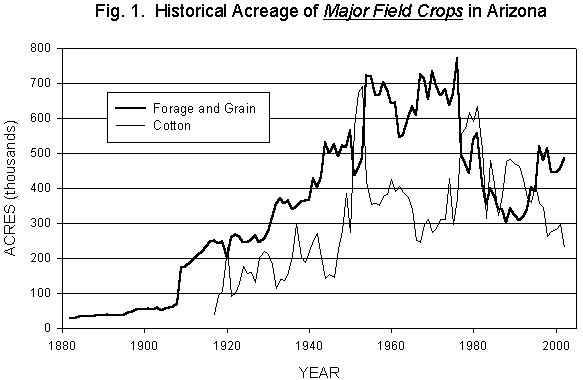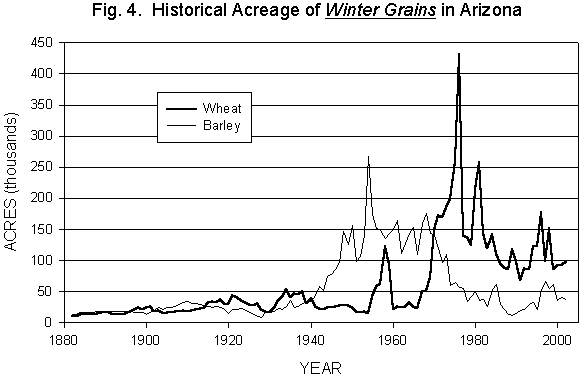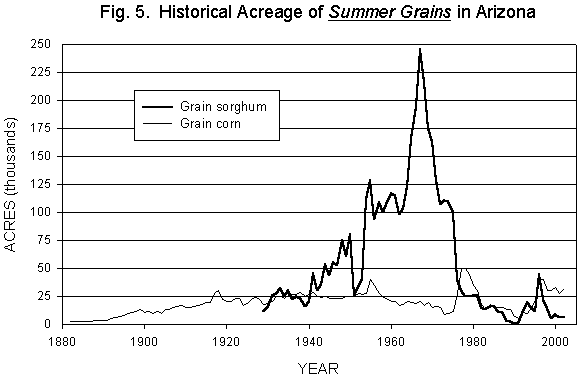Acreage was first reported in Arizona in 1882 for corn, wheat, and barley and in 1917 for cotton. Since 1917, cotton has averaged 314,000 acres and forage and grain crops have averaged 460,000 acres (Fig. 1). Acreage of major field crops in Arizona peaked between 1940 and 1980. In 2002, reported acreage is 485,000 acres for forage and grain crops and 239,000 acres for cotton. Since 1991, forage and grain crop acreage has increased by 178,000 acres (58%) and cotton acreage has decreased by 223,000 acres (48%).
Acreage of harvested alfalfa hay in Arizona has averaged about 176,000 acres between 1919 and 2002 (Fig. 2). Alfalfa was grown in the 1800's in Arizona, but acreage was not reported until 1919. The lowest acreage was 82,000 in 1920 and the highest acreage was 237,000 acres in 1944. The 2002 acreage of 225,000 acres is the 5th highest in 84 years of reported acreage. Alfalfa acreage has increased steadily since 1993, when alfalfa hay was harvested from 150,000 acres. Acreage of other hay (e.g. bermuda, sudangrass, and oats) has averaged 45,000 acres between 1919 and 2002 and was reported at 45,000 acres in 2002.
Corn silage acreage in Arizona has averaged about 8,000 acres since 1919
when first reported (Fig. 3). Corn silage acreage
has increased in the past 11 years from 5,000 acres in 1992 to 33,000
acres in 2002. Corn silage acreage has never been higher than in 2002,
and seven of the top eight years for corn silage acreage have been reported
from 1996 to 2002. Sorghum silage acreage has averaged about 10,000 acres
since the first year of record in 1929. Sorghum silage acreage peaked
at 50,000 acres in 1957, and is currently 7,000 acres.
Wheat grain acreage has averaged 63,000 acres since 1882 and 149,000 acres
since 1970 when semi-dwarf wheat was introduced. The peak wheat acreage
occurred in 1976 when 440,000 acres were harvested (Fig.
4). Wheat was harvested from 99,000 acres in 2002. Barley acreage
has averaged 55,000 acres since 1882 and averaged 112,000 acres between
1940 and 1980 when barley production peaked. The highest barley acreage
occurred in 1954 when 268,000 acres were produced. Barley was harvested
from 38,000 acres in 2002.
The historical average acreage for summer grains has been 58,000 acres for sorghum since 1929 and 19,000 acres for corn since 1882. The highest acreage reported for grain sorghum was 246,000 acres in 1967 (Fig. 5). Grain sorghum acreage dipped to about 1,000 acres in 1991, increased to 45,000 acres in 1996, and has decreased to 6,000 acres in 2002. Acreage of corn harvested for grain peaked at 50,000 acres in 1978, decreased to 5,000 in 1991, and has risen to 32,000 acres in 2002.
Note: This data was obtained from the National Agricultural Statistics Service Website (http://www.usda.gov/nass). Major field crops refer to cotton, hay, wheat, barley, oats, sorghum, and corn and does not include other field crops such as dry beans, jojoba, peanuts, safflower, and miscellaneous seeds. Cotton acreage represents Pima and upland cotton. Other hay was calculated as the difference between all hay and alfalfa hay. Wheat acreage represents all wheat and includes winter wheat and durum. The data presented is harvested acreage for the various crops. Forage crop acreage is underestimated by using harvested rather than planted acres. Certain crops, such as winter cereals, are planted and not harvested, but may be used for green manure or other purposes.
Issued in furtherance of Cooperative Extension work, acts of May 8 and June 30, 1914, in cooperation with the U.S. Department of Agriculture, James A. Christenson, Director Cooperative Extension, College of Agriculture and Life Sciences, The University of Arizona.
The University of Arizona is an equal opportunity, affirmative action institution. The University does not discriminate on the basis of race, color, religion, sex, national origin, age, disability, veteran status, or sexual orientation in its programs and activities.
Any products, services, or organizations that are
mentioned, shown, or indirectly implied in this web document do not imply
endorsement by The University of Arizona.
Information provided by:
Barry Bequette, plantdoc@ag.arizona.edu Extension Agent, Urban Horticulture
Barry Tickes, btickes@ag.arizona.edu Extension Agent, Yuma County
Mohammed Zerkoune, zerkoune@ag.arizona.edu Extension Agent, Agriculture
University of Arizona, Tucson, Arizona.
Material written September 2002.
For more Arizona Production Ag Information:
Home | Cotton | Veggies| Forages | Grains | Citrus | Crop x Crop | Insects | Diseases| Weeds | Pesticides | News | Weather | Research | Photos | Contacts | General Info. | Site Map
document located at: http://cals.arizona.edu/crops/counties/yuma/farmnotes/fn0902histacre.html
Copyright © 2001 University of Arizona,
College of Agriculture and Life Sciences
Webmaster: Al Fournier (fournier@ag.arizona.edu)




